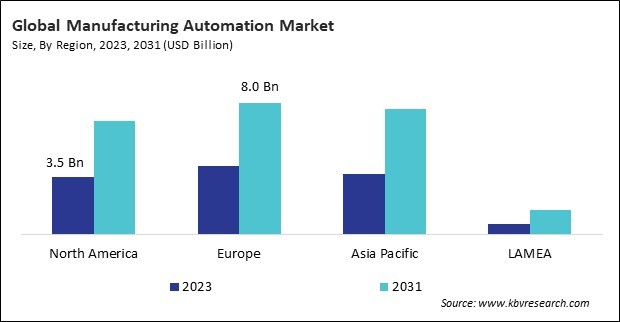Int'l : +1(646) 600-5072 | query@kbvresearch.com
Int'l : +1(646) 600-5072 | query@kbvresearch.com
Industry Insights | Market Trends | Highest number of Tables | 24/7 Analyst Support
According to a new report, published by KBV research, The Global Manufacturing Automation Market size is expected to reach $23.9 billion by 2031, rising at a market growth of 9.4% CAGR during the forecast period.
The Large Enterprises segment is leading the Global Manufacturing Automation Market by Enterprise Size in 2023; thereby, achieving a market value of $13.4 billion by 2031. Large manufacturing enterprises, particularly in the automotive, aerospace, and electronics industries, have long been at the forefront of automation adoption due to their ability to invest in cutting-edge technologies and integrate sophisticated systems across their global operations. These enterprises deploy advanced robotics, AI-driven solutions, and industrial IoT (IIoT) technologies to streamline complex processes, optimize supply chains, and boost production capacity. The scale of automation in large enterprises, coupled with their continuous investments in innovation.

The Process Manufacturing market is anticipating a CAGR of 10.7% during (2024 - 2031). The continuous production of commodities through chemical, biological, or mechanical processes is a common practice in industries such as pharmaceuticals, oil and gas, food and beverages, and chemicals through process manufacturing. Automation in process manufacturing focuses on optimizing production cycles, ensuring safety, and maintaining product consistency in large quantities. Integrating automation technologies, such as advanced sensors, PLCs, and real-time data analytics enables manufacturers to monitor and control production parameters more effectively.
The PLC market is generating the maximum revenue in the Global Manufacturing Automation Market by Technology in 2023; thereby, achieving a market value of $12.3 billion by 2031. Programmable Logic Controllers (PLC) are crucial for automating machinery, monitoring production lines, and controlling manufacturing processes. Their ability to handle real-time operations, adapt to different manufacturing needs, and offer high reliability makes them indispensable in automation. As industries continue to seek greater efficiency, PLCs have remained a preferred choice for manufacturers looking to enhance precision and control in their processes, particularly in sectors such as automotive, food and beverage, and pharmaceuticals.
The Services segment is registering a CAGR of 9.7% during (2024 - 2031). This segment includes consulting, system integration, training, and after-sales support services that ensure successful deployment and ongoing operation of automation systems. As manufacturers increasingly seek to optimize their automation investments, the demand for specialized services, including maintenance, upgrades, and data analytics support, has grown significantly. The combination of hardware dominance and the rising importance of service-based offerings reflects the comprehensive approach required for effective automation implementation across manufacturing sectors.
The Control Systems segment is leading the Global Manufacturing Automation Market by Solution in 2023; thereby, achieving a market value of $8.8 billion by 2031. Control systems, including programmable logic controllers (PLCs), distributed control systems (DCS), and supervisory control and data acquisition (SCADA) systems, are essential for automating and managing complex production processes. These systems give manufacturers real-time control and oversight of machinery and production lines, enabling precise adjustments, reducing errors, and enhancing productivity. The widespread adoption of control systems in the automotive, electronics, and food and beverages industries has been a key driver of their revenue dominance, as they offer reliability, scalability, and flexibility in managing large-scale operations.
The Transportation & Logistics segment shows a CAGR of 9.7% during (2024 - 2031). The increasing demand for efficient warehouse management and faster delivery times has led to the adoption of automated technologies, such as IoT-driven monitoring solutions, autonomous vehicles, and robotic sorting systems. These innovations help streamline processes such as order fulfillment, inventory management, and shipment tracking, significantly enhancing productivity while reducing human error. As global trade and e-commerce continue to expand, the transportation and logistics sector increasingly relies on automation to handle the complexities of modern supply chains.
The On-premises segment dominated the Global Manufacturing Automation Market by Deployment in 2023; thereby, achieving a market value of $14.9 billion by 2031. On-premises deployment involves installing automation systems directly within the manufacturing facility, such as control software and hardware infrastructure. This deployment model offers manufacturers greater control over their systems, ensuring data privacy and security. It is particularly important in industries handling sensitive information, such as aerospace and defense or pharmaceuticals. Additionally, on-premises systems provide lower latency and real-time processing capabilities, making them ideal for high-speed production environments with critical immediate responses.
The Material Handling Automation segment is anticipating a CAGR of 9.1% during (2024 - 2031). Material handling involves the movement, storage, and control of finished goods throughout the entirety of the manufacturing process. Automated solutions such as robotic arms, autonomous guided vehicles (AGVs), and smart conveyors are essential for improving efficiency and reducing manual labor in handling operations. These systems optimize workflow, minimize the risk of product damage, and enhance worker safety.
Full Report: https://www.kbvresearch.com/manufacturing-automation-market/
The Europe region dominated the Global Manufacturing Automation Market by Region in 2023, and would continue to be a dominant market till 2031; thereby, achieving a market value of $7,974.2 million by 2031. The Asia Pacific region is experiencing a CAGR of 9.9% during (2024 - 2031). Additionally, The North America region would register a CAGR of 9.1% during (2024 - 2031).
By Enterprise Size
By End-Use
By Component
By Technology
By Solution
By Deployment
By Industry Vertical
By Application
By Geography
Related Reports: